|
|
 |
|
Calanoida ( Ordre ) |
|
|
|
Clausocalanoidea ( Superfamille ) |
|
|
| |
| | | |
| Diaixidae Sars, 1902 ( Clausocalanoidea ) | | Ref.: | Sars, 1902 (1903) (p.57); van Breemen, 1908 a (p.81); Gurney, 1931 a (p.85); Rose, 1933 a (p.159); Bradford, 1969 b (p.502, Table 3); Andronov, 1974 a (p.1005); 1979 (p.100, spp. Key); Connell, 1981 (p.493); Bowman & Abele, 1982 (p.9); Razouls, 1982 (p.377); 1993 (p.310); Bradford & al., 1983 (p.122); Brodsky & al., 1983 (p.144, 147); Mauchline, 1988 (p.734, 740, Rem.: cuticular pores); Huys & Boxshall, 1991 (p.54, 419); Othman & Greenwood, 1994 (p.989, Redef.); Bradford-Grieve & al., 1999 (p.881, 903, 933); Ohtsuka & Huys, 2001 (p.461); Ohtsuka & al., 2003 (p.53, 62, Rem.); Boxshall & Halsey, 2004 (p.15; 49; 95: Def., Genera Key); Ferrari & Markhaseva, 2005 (p.45, Rem.); Vives & Shmeleva, 2007 (p.638); Blanco-Bercial & al., 2011 (p.103, Table 1, Fig.2, 3, 4, molecular biology, phylogeny); Markhaseva & al., 2014 (p.63, 67, Table 1, 2, 3, 4, 5, Def., Rem. p.81); Laakmann & al., 2019 (p.330, Table 1, fig. 1, 2, Table A, phylogenetic relationships)
Bradford-Grieve J.M., (2002 onwards). Key to calanoid copepod families. Version 1 : 2 oct 2002. http://www.crustacea.net/crustace/calanoida/index.htm  | | Rem.: | Boxshall & Halsey (2004, p.96) excluent le genre Pseudophaenna de la famille des Tharybidae pour être inclus dans cette famille.
10 G.: Anawekia, Byrathis, Diaixis, Procenognatha, Pseudophaennna, Ranthaxus, + 1 G (provisirement): Vensiava, Thoxancalanus.
Les types de soies sur Mx2 incluent cette famille dans le groupe des familles 'bradfordienne'.
Pour Markhaseva, Laakmann & Renz (2014, p.81) la famille inclut 15 genres: Byrathis, Cenognatha, Diaixis, Falsilandrumius, Grievella, Landrumius, Neoscolecithrix, Paraxantharus, Procenognatha, Ranthaxus, Sensiava, Xantharus, Xancithrix, Thoxancalanus. Anawekia Othman & Greenwood, 1994 insuffisamment décrit, et probablement synonyme de Diaixis, est maintenu dans cette famille jusqu'à une révision ultérieure.
Genre type: Diaixis Sars, 1902.
En 2015, Markhaseva crée le nouveau genre Vensiasa. Après analyse genétique, Laakmann & al., 2019 (p.330, Table 1) incluent 16 genres dans cette famille, dont 7 étaient antérieurement dans la famille des Scolecitrichidae Cenognatha, Falsilandrumius, Grievella, Landrumius, Neoscolecithrix, Paraxantharus, Xantharus) |  Issued from : E.L. Markhaseva, S. Laakmann & J. Renz in Mar. Biodiv., 2014, 44 [p.70, Fig.5]. Schematic view of right A1 in males of ''Bradfordian'' families. Diaixidae. Roman numerals: ancestral segments; black arrows: fused ancestral segments; black dotted arrows: position of geniculation or morphologically transformed segments. A1 of Sensiava and Procenognatha schematised after Markhaseva & Schulz (2006, 2010), remaining genera after Markhaseva (pers. obs.). |
 Issued from : E.L. Markhaseva, S. Laakmann & J. Renz in Mar. Biodiv., 2014, 44 [p.73, Table 1]. A2 armament (number of seta) in different ''Bradfordian'' genera (females). Diaixidae. c: coxa; b: basis; End1: endopodal segment 1; End2: endopodal segment 2; Exp: exopod. |
 Issued from : E.L. Markhaseva, S. Laakmann & J. Renz in Mar. Biodiv., 2014, 44 [p.74, Table 2]. Md armament (number of seta) in different ''Bradfordian'' genera (females). Diaixidae. b: basis; End1: endopod segment 1; End2: endopod segment 2; Exp: exopod; gn: gnathobase. |
 Issued from : E.L. Markhaseva, S. Laakmann & J. Renz in Mar. Biodiv., 2014, 44 [p.76, Table 3]. Mx1 armament (number of seta) in different ''Bradfordian'' genera (females). Diaixidae. pa: praecoxal arthrite (setal formula of praecoxal arthrite: terminal+posterior+anterior setae); ce: coxal endite; bp: proximal basal endite; bd: distal basal endite; End: endopod; Exp: exopod; Epi: epipodite.. |
 Issued from : E.L. Markhaseva, S. Laakmann & J. Renz in Mar. Biodiv., 2014, 44 [p.78, Table 4]. Mx2 armament (number of seta) in different ''Bradfordian'' genera (females). Diaixidae. at: attenuation; pe: praecoxal endite; ce: coxal endite; bp: proximal basal endite; bd: distal basal endite; el: enditic-like lobe of proximal endopopdal segment; End: endopod; w: worm-like seta; br: brush-like seta; sc: sclerotised seta. |
 Issued from : E.L. Markhaseva, S. Laakmann & J. Renz in Mar. Biodiv., 2014, 44 [p.80, Table 5]. Mxp setation (number of seta) in different ''Bradfordian'' genera (females). Diaixidae. at: attenuation; pes: praecoxal endites of syncoxa (from proximal to distal); ces: coxal endite of syncoxa; bp: basis proximal; bd: basis distal; End: endopod; . For more detailed morphology of the setae on the praecoxal of the maxilliped syncoxa see Markhaseva & Ferrari (2005) and Markhaseva & al. (2008). |
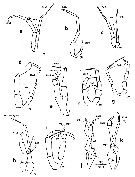 Issued from : E.L. Markhaseva, S. Laakmann & J. Renz in Mar. Biodiv., 2014, 44 [p.82, Fig.8]. P5 of males in Diaixidae. a: Xancithrix ohmani Markhaseva 2012; b: Neoscolecithrix caetanovi Alvarez 1985; c: Cenognatha farrani (Smirnov 1935); d: Procenognatha semisensata Markhaseva & Schulz 2010; e: Sensiava longiseta Markhaseva & Schulz 2006; f: Xantharus formosus Andronov 1981; g: Xantharus renatehaassae Schulz 1998; h: Paraxantharus brittae Schulz 2006; i: Byrathis arnei Schulz 2006; j: Diaixis trunovi Andronov 1981; k: Diaixis helenae Andronov 1981. Exp: exopod; End: endopod; R: right leg. |
 Issued from : G.A. Boxshall & S.H. Halsey in An Introduction to Copepod Diversity. The Ray Society, 2004, No 166, Part. I. [p.95]. Armature formula of swimming legs P1 to P4. Setation sometimes reduced, exopodal armature of P1 sometimes sexually dimorphic. Nota: Female P5 2-segmented with single apical spine in Pseudophaenna, absent in other genera. - Male P5 uniramous, qzymmetrical with bilobed proximal plate formed by fusion of intercoxal sclerite and protopodal segments in Diaixis, right leg typically 2-segmented, consisting of slender proximal segment fused to proximal plate and movable distal segment, often claw-like: left leg often subchelate; basis free or fused to coxal plate, exopod typically 3-segmented with apical segment often subchelate; slender unarmed 1st segment, slender 2nd segment often bearing distal processes and short 3rd segment armed variously with setae, lamellae or spinous processes. P5 slender in Pseudophaenna, 4-segmented on right, 5-segmented on left. - Eggs presumably released into water. |
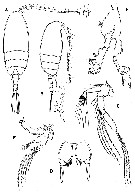 Issued from : G.A. Boxshall & S.H. Halsey in An Introduction to Copepod Diversity. The Ray Society, 2004, No 166, Part. I. [p.97, Fig.16]. Diaixidae. A, Diaixis hibernica habitus female; B, habitus male; C, female A2; D, Pseudophaenna typica female P5; E, Diaixis hibernica female Md; F, male P5. [Sars, 1902]. | | | | | (1) Anawekia Othman & Greenwood, 1994 | |
| | Ref.: | Othman & Greenwood, 1994 (p.989); Mauchline, 1998 (p.78: F; p.81: M); Bradford-Grieve, 2004 (p.287); Boxshall & Halsey, 2004 (p.96); Laakmann & al., 2019 (p.330, Table 1) | | Rem.: | Type: Anawekia spinosa Othman & Greenwood, 1994. Total: 3 spp. | | Remarques sur les dimensions et le sex-ratio: | | The mean female size is 0.860 mm (n = 6; SD = 0.0787) and the mean male size is 0.743 mm (n = 6; SD = 0.0408). The size ratio (male : female) is 0.866 (n = 3; SD = 0.0271). The sex ratio is 1. | | | | (2) Byrathis Markhaseva & Ferrari, 2005 | |
| | Ref.: | Markhaseva & Ferrari, 2005 a (p.128: Def., fig.31, Rem.); Schulz, 2006 (p.67: Rem.); Markhaseva & Renz, 2011 (p.49, 66: Rem.); Markhaseva & al., 2014 (p.81, Table 1, 2, 3, 4, Rem.); Renz & Markhaseva, 2015 (p.96, Table 4, fig.3, sex ratio, biogeography); Laakmann & al., 2019 (p.330, Table 1) | | Rem.: | Type: Xanthocalanus macrocephalon. Grice & Hulsemann,1970. Total: 7 spp. + 1 indet. | | Remarques sur les dimensions et le sex-ratio: | | The mean female size is 1.951 mm (n = 12; SD = 1.2346). The mean male size for one male only is 1.475 mm, and the size ratio for the male and female is 1. The sex ratio (female: male) provisionally 8. | 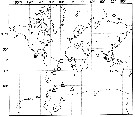 issued from : E.L. Markhaseva & Renz in Zootaxa, 2011, 2889. [p.61, Fig.9]. Distribution of species of Byrathis in the World Ocean. B. macrocephalon (black rhomboid). B. penicillatus (circle outlined). B. laurenae (black square). B. arnei (big triangle outlined). B. divae (black small triangle). B. lapterovum (rhomboid outlined). B. volcani (rhomboid outlined with crest). |
 Issued from : E.L. Markhaseva & F.D. Ferrari in Invertebrate Zool., 2005, 2 (2). [p.142, Fig.18]. Byrathis macrocephalon (Grice & Hulsemann, 1970) comb.n. female (holotype). A, posterior prosome and urosome (right lateral); B, exopod of A2; C, Md gnathobase (posterior); D, Md gnathobase, proximal; E, Mx2 (praecoxal, coxal and proximal basal endites); F, sensory setae of distal basal endite + ramus of Mx2; G, syncoxa of Mxp; H, distal part of basis and endopod of P1 (anterior view); Scale bars: 0.1 mm. | | | | | | Ref.: | Sars, 1902 (1903) (p.58); van Breemen, 1908 a (p.81); Rose, 1933 a (p.160); Andronov,1979 (p.100, clé spp.); Connell, 1981 (p.493); Razouls, 1982 (p.377); Bradford & al., 1983 (p.122); Mauchline, 1988 (p.734); Razouls, 1993 (p.310); Othman & Greenwood, 1994 (p.988, Redef., 2 groupes: 'pygmaea' et 'centrura'); Mauchline, 1998 (p.78, 88: F; p.81, 89: M); Bradford-Grieve & al., 1999 (p.881, 934: spp Key.); Andronov, 2002 (p.2, 11, clé spp.); Bradford-Grieve, 2004 (p.287); Boxshall & Halsey, 2004 (p.96); Markhaseva & Ferrari, 2005 a (p.111, Fig.31, Rem.); Vives & Shmeleva, 2007 (p.639, spp. Key); Markhaseva & al., 2014 (p.81, Table 1, 2, 3, 4, Rem.); Laakmann & al., 2019 (p.330, Table 1) | | Rem.: | Type: Scolecithrix hibernica A. Scott, 1896.
formes plus ou moins hyperbenthiques. 8 spp. | | Remarques sur les dimensions et le sex-ratio: | | La moyenne des longueurs des femelles est de 0,913 mm (n= 8; S= 0,144; Cv= 0,158) et de 0,791 mm pour les mâles (n= 7; S= 0,091; Cv= 0,115). Le rapport des longueurs (M/F) est de 0,910 ou 91 % (n= 7; S= 0,045; Cv= 0,05). Le rapport des sexes (F/M) est de 1,29. |  Issued from : E.L. Markhaseva, S. Laakmann & J. Renz in Mar. Biodiv., 2014, 44 [p.70, Fig.5]. Schematic view of right A1 in males of ''Bradfordian'' families. Diaixidae. Roman numerals: ancestral segments; black arrows: fused ancestral segments. | | | | | (4) Procenognatha Markhaseva & Schulz, 2010 | |
| | Ref.: | Markhaseva & Schulz, 2010 (p.4); Markhaseva & al., 2014 (p.82, Table 1, 2, 3, 4, Rem.); Renz & Markhaseva, 2015 (p.96, Table 4, fig.3, sex ratio, biogeography); Laakmann & al., 2019 (p.330, Table 1) | | Rem.: | Type: Procenognatha semisensata. Total: 1 sp. | | Remarques sur les dimensions et le sex-ratio: | | For 0ne species, total Female: 2.50-2.75; Male: 1.95-2.30. Length ratio male : female = ± 0.81. The sex ratio is 1. |  Issued from : E.L. Markhaseva, S. Laakmann & J. Renz in Mar. Biodiv., 2014, 44 [p.70, Fig.5]. Schematic view of right A1 in males of ''Bradfordian'' families. Diaixidae. Roman numerals: ancestral segments; black arrows: fused ancestral segments; black dotted arrows: position of geniculation or morphologically transformed segments. A1 of Procenognatha schematised after Markhaseva & Schulz (2006, 2010), remaining genera after Markhaseva (pers. obs.). |
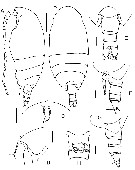 Issued from : E.I. Markhaseva & K. Schulz in Peoc. Zool. Inst. RAS, 2010, 314 (1). [p.6, Fig. 1] Procenognatha semisensata Holotype from 00°45'N, 05°35'W (above the sea bed at depth of 5141 m). Female: A-B, habitus (lateral and dorsal, respectively); C-D, rostrum ( ventral and lateral, respectively); E-G, posterior prosome and urosome ( dorsal and lateral, respectively); H, genital double -somite (ventral). Scale bars: 0.5 mm (A, B); 0.1 mm (C-H). C, D, F = paratype. |
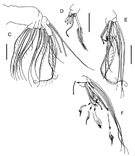 Issued from : E.I. Markhaseva & K. Schulz in Peoc. Zool. Inst. RAS, 2010, 314 (1). [p.7, Fig. 2 C-F] Procenognatha semisensata Female from 00°45'N, 05°35'W (above the sea bed at depth of 5141 m). C, maxilla (brush-like setae not shown); D, E, F, Mx2 (different limbs). Scale bars: 0.1 mm. C-E: holotype; F: paratype. Nota: - Praecoxal endite bearing 5 setae, coxal (previously considered as distal praecoxal endite) with 3 setae; ; basal endites (previously considered as coxal endites) with 3 setae each; lobe of proximal endopodal segment (previously considered as proximal basal endite) with 4 setae, all sclerotized; - Endopod with 9 setae, 3 terminal setae sclerotized and 6 brush-like setae of different morphology: the longest, poorly sclerotized, seta plumose from one side, with poorly developed brush-like head, 1 short sensory seta, with poorly developed brush on top, and 4 well-developed brush-like sensory setae (1 thick and 3 thin). |
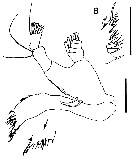 Issued from : E.I. Markhaseva & K. Schulz in Peoc. Zool. Inst. RAS, 2010, 314 (1). [p.7, Fig. 3 A-B] Procenognatha semisensata Female from 00°45'N, 05°35'W (above the sea bed at depth of 5141 m). A, Md; B, gnathobase (cutting edge) Scale bars: 0.1 mm. A: holotype; B, paratype. Nota: gnathobase cutting edge with 8 teeth; exopod of 5 segments with 1, 1, 1, 1 and 2 setae; endopodal segment 1 with 2 setae, endopodal segment 2 with 9 setae; basis with 4 setae (1 of which very small). |
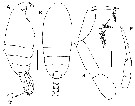 Issued from : E.I. Markhaseva & K. Schulz in Peoc. Zool. Inst. RAS, 2010, 314 (1). [p.11, Fig. 3 A-B, G-F] Procenognatha semisensata Male from 00°45'N, 05°35'W (above the sea bed at depth of 5141 m). A-B, habitus (lateral and dorsal, respectively); F, P5 right; G, P5 left. Scale bars: 0.5 mm (A-B); 0.1 mm (F, G) . | | | | | (5) Pseudophaenna Sars, 1902 | |
| | Ref.: | Sars,1902 (1903) (p.43); van Breemen, 1908 a (p.57); Rose, 1933 a (p.126); Bradford, 1973 (p.138, Rem.); Razouls, 1982 (p.287, 368); Bradford & al., 1983 (p.123, Déf., p.126); Razouls, 1993 (p.311); Mauchline, 1998 (p.87: F; p.89: M); Vyshkvartzeva, 2001 (p.77: Rem.); Bradford-Grieve, 2004 (p.287); Boxshall & Halsey, 2004 (p.96); Markhaseva & al., 2014 (p.83, Table 1, 2, 3, 4, Rem.: p.84); Laakmann & al., 2019 (p.330, Table 1: considered as incertae sedis genera) | | Rem.: | Type: Pseudophaenna typica Sars, 1903. Total: 1 sp.
Ce genre, placé parmi les Tharybidae, est transféré dans cette famille par Boxshall & Halsey (2004, p.96, 210). | | Remarques sur les dimensions et le sex-ratio: | | Only one specimen measured: female body length : 1,60 mm and male: 1,40 mm. The size ratio (male: female) is 0.875. The sex ratio is 1. |  Issued from : E.L. Markhaseva, S. Laakmann & J. Renz in Mar. Biodiv., 2014, 44 [p.73, Table 1]. A2 armament (number of seta) in different ''Bradfordian'' genera (females). Pseudophaenna: Unresoved family. |
 Issued from : E.L. Markhaseva, S. Laakmann & J. Renz in Mar. Biodiv., 2014, 44 [p.75, Table 2]. Md armament (number of seta) in different ''Bradfordian'' genera (females). Pseudophaenna: Unresolved family. |
 Issued from : E.L. Markhaseva, S. Laakmann & J. Renz in Mar. Biodiv., 2014, 44 [p.77, Table 3]. Mx1 armament (number of seta) in different ''Bradfordian'' genera (females). Pseudophaenna: Unresolved family. |
 Issued from : E.L. Markhaseva, S. Laakmann & J. Renz in Mar. Biodiv., 2014, 44 [p.79, Table 4]. Mx2 armament (number of seta) in different ''Bradfordian'' genera (females). Pseudophaenna: Unresolved family. |
 Issued from : E.L. Markhaseva, S. Laakmann & J. Renz in Mar. Biodiv., 2014, 44 [p.81, Table 5]. Mxp setation (number of seta) in different ''Bradfordian'' genera (females). Pseudophaenna: Unresolved family. | | | | | (6) Ranthaxus Markhaseva & Schulz, 2010 | |
| | Ref.: | Markhaseva & Schulz, 2010 (p.13, Table 1); Markhaseva & al., 2014 (p.82, Table 1, 2, 3, 4, Rem.); Renz & Markhaseva, 2015 (p.96, Table 4, fig.3, biogeography); Laakmann & al., 2019 (p.330, Table 1). | | Rem.: | Total: 1 sp. | | Remarques sur les dimensions et le sex-ratio: | | The body size for one female only is 1.200 mm. Male unknown. | 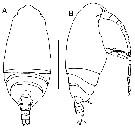 Issued from : E.I. Markhaseva & K. Schulz in Peoc. Zool. Inst. RAS, 2010, 314 (1). [p.18, Fig. 9 A-B] . Ranthaxux vermiformis Female from 00°01'S, 02°29'W (above the sea bed at depth of 5058 m). A-B, habitus (dorsal and lateral, respectively). Nota: Cephalosome and pediger 1 fused, pedigers 4 and 5 fused. Rostrum as bifucaye plate with filaments. Caudal rami with 4 terminal setae plus 1 dorsolateral and ventral setae each. |
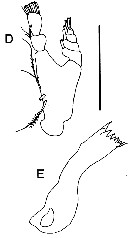 Issued from : E.I. Markhaseva & K. Schulz in Peoc. Zool. Inst. RAS, 2010, 314 (1). [p.7, Fig. 3 D, E]. Ranthaxux vermiformis Female from 00°01'S, 02°29'W (above the sea bed at depth of 5058 m). D, Md (palp); E, Md (gnathobase). Nota: Gnathobase bearing 8 teeth. |
 Issued from : E.I. Markhaseva & K. Schulz in Peoc. Zool. Inst. RAS, 2010, 314 (1). [p.7, Fig. 3 C-D]. Ranthaxux vermiformis Female from 00°01'S, 02°29'W (above the sea bed at depth of 5058 m). C, Mx2; D, Mx2 (endopod). Distal praecoxal endite and both coxal endites with 3 setae (1 of which sensory); proximal basal endite with 4 setae (2 of which sensory); endopod with 6 worm-like sensory setae (4 long and 2 short). |
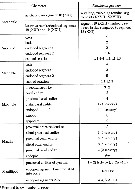 issued from : E.L. Markhaseva & Schulz in Proc. Zool. Inst. RAS, 2010, 314 (1). [p.16, Table.1]. Selected character states of Ranthaxus Females. Abbreviations: br = brush-like; sel = sclerotized; w = worm-like sensory setae. | | | | | (7) Sensiava Markhaseva & Schulz, 2006 | |
| | Ref.: | Markhaseva & Schulz, 2006 (p.1); Markhaseva & Renz, 2011 (p.67, Rem.); Markhaseva & al., 2014 (p.82, Table 1, 2, 3, 4, Rem.) ; Renz & Markhaseva, 2015 (p.96, Table 4, Fig.3, sex ratio, biogeography); Laakmann & al., 2019 (p.330, Table 1) | | Rem.: | Type species: Sensiava longiseta. Total: 3 spp. + 1 indet.
Inclus provisoirement par les auteurs dans la famille des Diaixidae. | | Remarques sur les dimensions et le sex-ratio: | | The mean female size is 2.992 mm (n = 6; SD = 1.0268), and in male 3.8 mm (n = 4; SD = 1.0456). The size ratio (Male: Female) is 0.93. |  Issued from : E.L. Markhaseva, S. Laakmann & J. Renz in Mar. Biodiv., 2014, 44 [p.70 Fig.5]. Schematic view of right A1 in males of ''Bradfordian'' families. Diaixidae. Roman numerals: ancestral segments; black arrows: fused ancestral segments; black dotted arrows: position of geniculation or morphologically transformed segments. A1 of Sensiava schematised after Markhaseva & Schulz (2006, 2010), remaining genera after Markhaseva (pers. obs.). | | | | | (8) Thoxancalanus Markhaseva, Laakmann & Renz, 2013 | |
| | Ref.: | Marhkhaseva & al., 2014 (p.65, Def., Table 1, 2, 3, 7, Rem.: p.82); Renz & Markhaseva, 2015 (p.96, Table 4, Fig.3, sex ratio, biogeography); Laakmann & al., 2019 (p.330, Table 1) | | Rem.: | Type: Thoxancalanus spinatus. Total: 1 sp. | 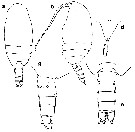 Issued from : E.L. Markhaseva, S. Laakmann & J. Renz in Mar. Biodiv., 2014, 44 [p.66, Fig.1]. Thoxancalanus spinatus Markhaseva, Laakmann & Renz, 2013; Female: a-b, habitus (dorsal and lateral, respectively); d, rostrum (anteroventral view); e, g, posterior prosome and urosome (dorsal and lateral, respectively). |
 Issued from : E.L. Markhaseva, S. Laakmann & J. Renz in Mar. Biodiv., 2014, 44 [p.68, 69, Figs.3, 4]. Thoxancalanus spinatus Markhaseva, Laakmann & Renz, 2013; Female: a, Mxp; b, Mx2; c, P1 (anterior view). |
 Issued from : E.L. Markhaseva, S. Laakmann & J. Renz in Mar. Biodiv., 2014, 44 [p.73, Table 1]. Thoxancalanus spinatus Markhaseva, Laakmann & Renz, 2013; Female: A2 armament (number of setae. |
 Issued from : E.L. Markhaseva, S. Laakmann & J. Renz in Mar. Biodiv., 2014, 44 [p.75, Table 2]. Thoxancalanus spinatus Markhaseva, Laakmann & Renz, 2013; Female: Md armament (number of seta) |
 Issued from : E.L. Markhaseva, S. Laakmann & J. Renz in Mar. Biodiv., 2014, 44 [p.77, Table 3]. Thoxancalanus spinatus Markhaseva, Laakmann & Renz, 2013; Female: Mx1 armament (number of seta). |
 Issued from : E.L. Markhaseva, S. Laakmann & J. Renz in Mar. Biodiv., 2014, 44 [p.79, Table 4]. Thoxancalanus spinatus Markhaseva, Laakmann & Renz, 2013; Female: Mx2 armament (number and kind of seta). |
 Issued from : E.L. Markhaseva, S. Laakmann & J. Renz in Mar. Biodiv., 2014, 44 [p.81, Table 5]. Thoxancalanus spinatus Markhaseva, Laakmann & Renz, 2013; Female: Mxp setation (number of seta). | | | | | (9) Vensiasa Markhaseva, 2015 | |
| | Ref.: | Markhaseva, 2015 (p.183); Laakmann & al., 2019 (p.330, Table 1) | | Rem.: | Type species: Vensiasa incerta Markhaseva, 2015.
Diagnosis from Markhaseva (2015, p.183):
Female:
- Cehalosome and pediger 1, pedigers 4 and 5 incompletely separate.
- posterior corners, in dorsal view, triangular ; as rounded lobes, in lateral view.
- Rostrum as a poorly developed plate with 2 filaments.-
A1 24 free segments.
- Coxa of A2 with 1 seta; basis with 2 setae; endopodal segment 1 with 1 seta, exopod setal formula 0,0-0-1, 1, 1, 1, 1, 1, 3.
- Gnathobase of Md with 7-8 teeth; exopod 5-segmented with 1,1,1,1, and 2 setae; endopod segment 1 with 3 setae, 2nd endopod with 9 setae; basis with 3 setae.
- Mx1 praecoxal arthrite with 9 terminal spines, 2 posterior setae and 1 anterior seta; coxal endite with 3 setae, coxal epipodite with 8-9 setae; proximal basal endite with 3 setae, distal basal endite with 2-3 setae; endopod with 5 setae, exopod with 8 setae.
- Mx2 praecoxal endite bearing 5 setae and attenuation, coxal and basal endites with 3 setae each; enditic-like lobe of proximal endopodal segment with 4 setae; 2 setae of distal basal endite and 2 setae of enditic-like lobe equal in length and curved distally; endopod with 6 worm-like (w) and 2 brush-like (br) sensory setae, 3 terminal worm-like setae long, 3 proximal worm-like setae short and very thin and 2 brush-like setae: 1 thick with brush well developed and 1 thin with poorly developed brush.
- Mxp syncoxa with 1, 2 and 3 setae on praecoxal endites.
- P1 to P4 typical clausocalanoidean setation and segmentation.
- P5 uniramous, symmetrical, 3-segmentesd, with 4 setal elements terminally.
Male:
- Rostrum as in female.
- Cephalosome and pediger 1, pedigers 4 and 5 separate.
- Prosome posterior corners as short rounded lobes.
- Right A1 23-segmented; left 24 free segments; ancestral segments X-XI fused.
- Oral appendages sexually dimorphic and moderately reduced compared to females.
- Setatio of A2 asin female.
- Number of setae on Md basis and endopod segment 2 as in female, endopod segment 1 with 2 setae.
- Armament of Mx1 differs from female in: praecoxal arthrite with 1 posterior seta; coxal epipodite with 7 setae; proximal basal endite with 2 setae, and exopod with 7 setae.
- Mx2 praecoxal endite with 4 setae, other lobes with the same setal numbers as in female.
- Mxp setation of syncoxa as in female, distal endopod setae more than 1.6 times longer than basis.
- P1 to P4 as in female.
- P5 nearly as long as urosome; protopods asymmetrical, right leg uniramous, 3-segmented; left leg biramous, endopod longer than 3-segmented exopod.
The new genus Vensiasa is defined among ''Bradfordians'' by the morphology of the sensory setae on the maxillary (Mx2) endopod (6w + 2br), their structure is an apomorphy for the genus: the 3 proximal worm-like setae are remarkably short and thin, 1 brush-like seta is very thin with poorly developed brush and 1 brush-like seta is very thick, brush well developed. Mx1 endopod with 5 setae (vs 7-12 in other diaixids) and male's P5 protopods asymmetrical; left P5 endopod longer than 3-segmented exopod (vs in other diaixids if protopods asymmetrical, then left endopod rudimentary or absent).
The new genus appears to be more closely related to the genus Sensiava. | 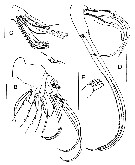 Issued from : E.L. Markhaseva in Proc. Zool. Inst. RAS, 2015, 319 (2). [p.188, Fig. 3, B-E]. Vensiasa incerta type species: B, maxilla; C, maxilla endopod (arrow marks head of a thin brush-like seta); D, maxilla, endopod and enditic-like lobe of proximal endopodal segment; ; E, maxilla, praecoxal endite. Scale bars = 0.1 mm. | | | | | (10) Xancithrix Markhaseva, 2012 | |
| | Ref.: | Markhaseva, 2012 (p.296); Markhaseva & al., 2014 (p.82, Table 1, 2, 3, 4, Rem.) ; Renz & Markhaseva, 2015 (p.96, Table 4, Fig.3, sex ratio, biogeography); Laakmann & al., 2019 (p.330, Table 1) | | Rem.: | Type: Xancithrix ohmani. Total: 1 sp. | | Remarques sur les dimensions et le sex-ratio: | | Total body length for 3 females: 4.50-4.55 mm; only one male 4.6 mm. | | | | | | | | | | | |
|
|
 Toute utilisation de ce site pour une publication sera mentionnée avec la référence suivante : Toute utilisation de ce site pour une publication sera mentionnée avec la référence suivante :
Razouls C., Desreumaux N., Kouwenberg J. et de Bovée F., 2005-2025. - Biodiversité des Copépodes planctoniques marins (morphologie, répartition géographique et données biologiques). Sorbonne Université, CNRS. Disponible sur http://copepodes.obs-banyuls.fr [Accédé le 30 décembre 2025] © copyright 2005-2025 Sorbonne Université, CNRS
|
|
 |
 |



















